In today’s world, where environmental concerns are becoming increasingly urgent, the role of parenting has taken on a new dimension. As parents, we have the unique opportunity to shape the future not only through the choices we make every day but also the values we instill in our children. Imagine the impact we could have if every household embraced eco-friendly practices — raising children who are not only mindful of their own health but also of the planet’s well-being.
This blog post is here to guide you through simple, effective ways to make your parenting more green. From sustainable baby products to energy-efficient homes, we’ll explore practical steps you can take to reduce your family’s environmental footprint. By making small, intentional changes, you can create a healthier environment for your children and set a positive example for future generations.
Whether you’re a new parent or you’re already in the thick of it and looking to refine your current game plan, there’s something here for everyone. Let’s take this opportunity to contribute to the future together and make our parenting — and our planet — a little greener.
Sustainable Baby Products
As parents, we naturally want the best for our children, and that includes ensuring they grow up in a safe, healthy environment. One big, and often neglected, step toward this is choosing sustainable baby products that minimize environmental impact while simultaneously providing the best care for our little ones. More often than not, better choices for the environment coincide with healthier decisions for little people (and bigger people).
Here are some key areas to focus on:
Eco-Friendly Diapers
Diapers are a significant source of waste, with billions ending up in landfills each
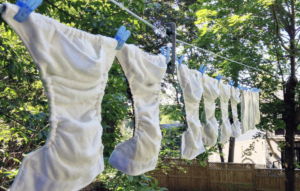
year. Consider the benefits of using cloth diapers or even biodegradable options:
- Cloth Diapers: These are reusable, reducing landfill waste significantly. Modern cloth diapers are convenient, with snap or Velcro closures, and come in various sizes and styles.
- Biodegradable Diapers: If cloth diapers aren’t feasible for your family, biodegradable diapers are certainly a better alternative to traditional disposables. Made from sustainable materials, they break down faster and have a smaller environmental footprint.
Natural Baby Care Products
Babies have sensitive skin that can react to harsh chemicals found in many 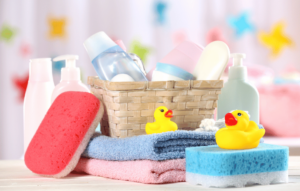 conventional products. The skin is also incredibly porous and has been found to absorb the majority of the contaminates it comes in contact with; things do not simply stay on the outside because we put them on the outside. Opt for natural baby care products at all costs:
conventional products. The skin is also incredibly porous and has been found to absorb the majority of the contaminates it comes in contact with; things do not simply stay on the outside because we put them on the outside. Opt for natural baby care products at all costs:
- Organic Lotions and Soaps: These are made from natural ingredients free of harmful chemicals and additives.
- Shampoos and Conditioners: Look for products that are free from sulfates, parabens, synthetic fragrances, and other toxic ingredients – be vigilant to only use products with natural ingredients to give your little ones the best.
Eco-Friendly Toys
The toys our children play with can also contribute to a greener planet. Choose toys made from sustainable, non-toxic materials:
- Wooden Toys: Often more durable than plastic, wooden toys can be passed down through generations. Look for those made from sustainably sourced wood.
- Recycled Materials: Many companies now produce toys from recycled plastic or other materials, reducing waste and promoting sustainability.
By starting with these small, manageable changes, you can significantly reduce your family’s environmental impact while ensuring your kid is safe and healthy. These choices not only directly benefit your child but also set a positive example for them as they grow, fostering an early appreciation for sustainability and environmental stewardship.
Green Feeding Practices
Feeding your child is one of the most intimate and quintessential aspects of parenting. By adopting greener feeding practices, you can ensure that this daily ritual is not only healthy for your child but also for the planet. Here are some strategies to consider:
Breastfeeding
I mean, this is obvious or certainly should be anyway, but breastfeeding is naturally ultra eco-friendly and offers serious benefits:
- Environmental Impact: It reduces the need for formula production, packaging, and transportation, which all contribute to greenhouse gas emissions.
- Health Benefits: Breast milk is the optimal source of nutrition for babies, promoting significantly better health outcomes and reducing medical waste associated with formula feeding.

Eco-Friendly Bottles and Utensils
When breastfeeding isn’t an option or for supplemental feeding, choose eco-friendly bottles and utensils:
- BPA-Free Bottles: Opt for bottles made from glass or BPA-free plastic to avoid harmful chemicals.
- Reusable Utensils: Stainless steel or bamboo utensils are durable and biodegradable, reducing plastic waste.
Homemade Baby Food
Making your own baby food can be a fun and fulfilling way to ensure your child is eating nutritious, eco-friendly meals instead of pre-processed and preserved foods:
- Organic Ingredients: Use organic fruits and vegetables to avoid pesticides and support sustainable farming practices.
- Reusable Containers: Store homemade baby food in glass jars or silicone pouches instead of single-use plastic containers.

- Reduced Packaging: By preparing baby food at home, you significantly cut down on the packaging waste associated with store-bought options.
These green feeding practices not only promote the health and well-being of your child but also contribute to a more sustainable lifestyle. By choosing eco-friendly feeding options, you set a strong foundation for a lifetime of healthy and environmentally conscious choices.
Reducing Household Waste
Creating a green home environment involves reducing waste wherever possible. By adopting a few simple practices, you can minimize your household’s environmental impact and set a positive example for your children. Here are some effective strategies:
Clothing
Kids grow quickly, and their clothing needs can generate a lot of waste. Consider these eco-friendly alternatives to the conventional methods:
- Buying Second-Hand: Thrift stores, consignment shops, and online marketplaces offer used children’s clothing at a fraction of the cost of new items.
- Swapping and Donating: Organize clothing swaps with friends or local parenting groups. Donate outgrown clothes to charities to extend their life cycle.
- Recycling Programs: Participate in programs that recycle textiles to ensure that old clothes are repurposed rather than ending up in landfills.
Smart Toy Management
Toys tend to accumulate quickly, leading to clutter and waste. Being smart about toys can go a long way:
- Minimizing Purchases: Buy fewer toys and focus on high-quality, durable items that can withstand extensive play.
- Rotating Toys: Keep a portion of your child’s toys stored away and periodically rotate them. This keeps toys feeling new and exciting without needing to buy more.
Recycling and Composting
Teaching children about waste management from an early age is crucial for fostering environmental responsibility:
- Recycling: Set up a proper recycling system at home. Explain to your children what can be recycled and involve them in the sorting process.
- Composting: Create a compost bin for organic waste. Teach your kids about composting and how it benefits the environment by reducing landfill waste and creating nutrient-rich soil.
These practices not only benefit the planet but also instill valuable lessons in your children about the importance of sustainability and responsible consumption.
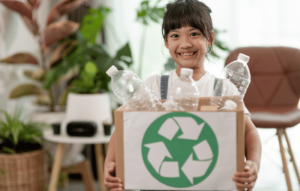
Eco-Friendly Transportation and Environmental Responsibility
By adopting eco-friendly transportation methods and teaching your children about environmental responsibility, you can significantly reduce your family’s carbon footprint and foster a deep appreciation for the planet. Here are some effective strategies you can start implementing anytime:
Eco-Friendly Transportation
Making green choices in how you get around can have a significant impact on the environment:
- Walking and Biking: Whenever possible, choose walking or biking for short trips. It’s a great way to reduce carbon emissions and incorporate physical
 activity into your daily routine. Be sure to communicate with your kids that it not only benefits you but also the planet by not using fossil fuels unless necessary.
activity into your daily routine. Be sure to communicate with your kids that it not only benefits you but also the planet by not using fossil fuels unless necessary. - Public Transportation: Use public transportation for longer distances whenever feasible. It’s often more environmentally friendly than driving a car and can be a fun adventure for kids.
- Eco-Friendly Car Choices: If you need a car, consider investing in a hybrid or electric vehicle. These options produce fewer emissions and are becoming more accessible and affordable.
Teaching Environmental Responsibility
Instilling eco-friendly values in your children can have long-lasting effects on their behavior and attitudes toward the environment:
- Nature Activities: Encourage outdoor play and activities that connect children with nature, such as hiking, gardening, or visiting parks. This grows a love for the environment and an understanding of its importance.
- Educational Resources: Use books, shows, and apps that focus on environmental education. There are many resources designed to teach children about sustainability in an engaging and age-appropriate way.
- Community Involvement: Participate in local environmental initiatives and clean-up events. Involving children in these activities helps them see the impact of collective efforts and instills a sense of responsibility towards their community.
Closing Thoughts
As we navigate the journey of parenthood, it’s essential to recognize the profound impact our choices have not only on our children but also on the world they will inherit. By adopting some eco-friendly parenting practices, we can create a healthier environment for our families and grow a deep-seated appreciation for the planet in the next generations.
From choosing sustainable baby products and embracing green feeding practices to reducing household waste and opting for eco-friendly transportation, every small change adds up. Teaching our children about environmental responsibility through nature activities, educational resources, and community involvement further reinforces these values, ensuring they grow up with a strong sense of stewardship.
Remember, the path to a greener lifestyle doesn’t require perfection. Start with manageable changes and build from there. Whether it’s switching to cloth diapers, making homemade baby food, recycling, or walking instead of driving, each step contributes to a more sustainable future.
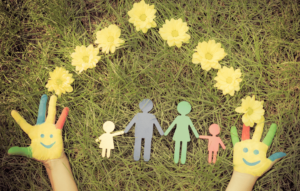
Let’s embrace the opportunity to lead by example, showing our children that caring for the planet is a vital part of life. Together, we can make a significant difference, one eco-friendly choice at a time. By raising environmentally conscious children, we are not only protecting their future but also creating a legacy of love and respect for the Earth.
So, take the first step today. Make your parenting more green, and watch as your efforts ripple out to inspire others and create a better world for all. Your dedication to sustainable living will leave a lasting impact, proving that the journey of a thousand miles truly begins with a single step.


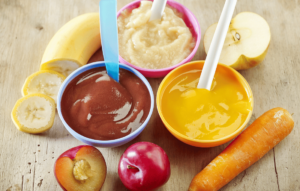
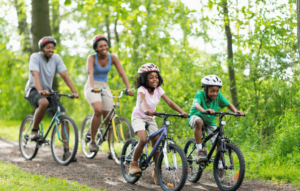 activity into your daily routine. Be sure to communicate with your kids that it not only benefits you but also the planet by not using fossil fuels unless necessary.
activity into your daily routine. Be sure to communicate with your kids that it not only benefits you but also the planet by not using fossil fuels unless necessary.





